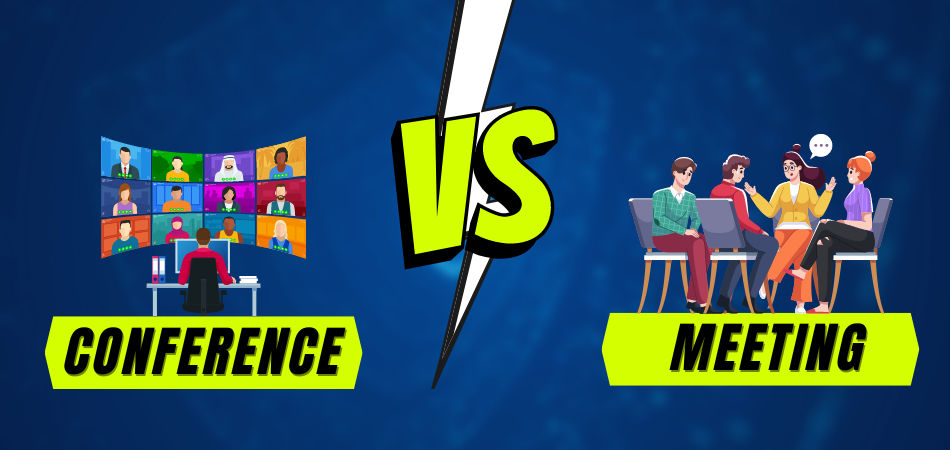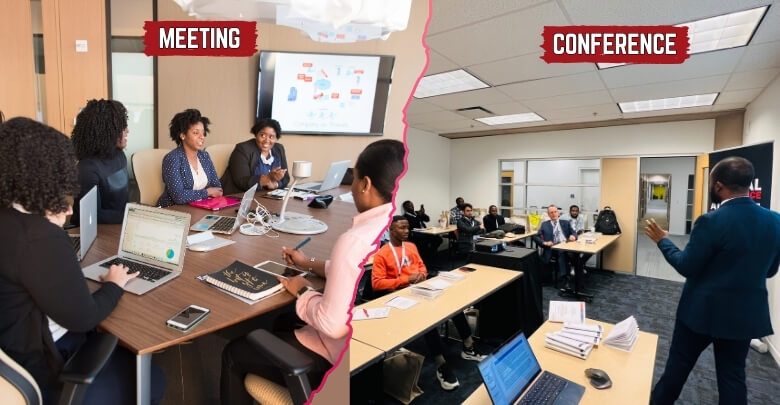In professional and social gatherings, the terms “meeting” and “conference” are often used interchangeably. However, while these terms seem similar, they represent distinct events with unique characteristics and purposes.
Individuals and organizations must understand the differences between meetings and conferences to effectively plan and participate in these gatherings. So, what is the difference between a meeting and a conference?
A meeting is a smaller-scale gathering for discussions and decision-making, while a conference is a larger-scale event with multiple sessions, presentations, and networking opportunities.
This article delves into the difference between a meeting and a conference. By exploring these distinctions, readers can better understand when to convene a meeting or participate in a conference, ensuring they choose the most suitable format to meet their goals and maximize their professional or social endeavors.
So, let’s dive into the intricacies of meetings and conferences and explore the key differences that set them apart.
The Concept Of A Meeting
A meeting is a scheduled event where participants assemble to discuss, exchange information, and decide on specific topics. The primary purpose of a meeting is to facilitate effective communication, coordinate efforts, and achieve common goals.
Types Of Meetings
- Formal Meetings: These meetings follow a structured format and have predefined objectives. They often involve a set agenda and a formal process for decision-making.
- Board Meetings: Board meetings are specific to organizations and involve gathering key decision-makers, such as the board of directors or executives, to discuss and make strategic decisions.
- Informal Gatherings or Meetings: Informal meetings are less structured and more casual. They allow open discussions, brainstorming, and idea sharing among participants.
Key Components Of A Meeting
- Meeting Agenda: An agenda outlines the topics, objectives, and order of discussion for a meeting. It helps keep the meeting focused and covers all relevant points.
- Discussions and Questions: Meetings involve active discussions among participants, who share their perspectives and insights, and ask questions to gain clarity or seek further information.
- Time Frame and Frequency: Meetings have a specified time frame for discussions and decision-making. They range from short meetings of a few minutes to longer sessions lasting several hours. The frequency of meetings varies based on the organization’s needs, with some occurring daily, weekly, monthly, or on an ad-hoc basis.
The Concept Of A Conference
A conference is a gathering of people, often from diverse backgrounds, who come together to participate in presentations, discussions, workshops, and networking activities. The primary purpose of a conference is to facilitate the dissemination of information, promote collaboration, and advance knowledge within a specific field or industry.
Types Of Conferences
- Professional or Academic Conferences: These conferences cater to researchers, scholars, and professionals in various fields. The opportunity to attend academic conferences enables you to present research findings, share insights, and engage in intellectual discussions on a platform created specifically for scholarly discourse.
- Business or Corporate Conferences: Business conferences focus on specific industries or sectors, allowing professionals to exchange ideas, showcase products or services, and explore potential collaborations or partnerships.
- Conferences for Students: These conferences are tailored to students and young professionals, offering opportunities to learn, network, and gain exposure in their respective fields of study or interest.
Key Components Of A Conference
- Presentations: Conferences feature presentations by experts, researchers, or industry leaders on relevant topics. These presentations include keynote speeches, panel discussions, or individual talks.
- Breakout Sessions and Workshops: They often include smaller breakout sessions or workshops where participants delve deeper into specific subjects, engage in interactive activities, and acquire practical skills or knowledge.
- Networking Opportunities: Conferences provide ample networking opportunities, allowing attendees to connect with peers, experts, potential mentors, or brand representatives. Networking can occur during dedicated networking sessions, social events, or informal gatherings.
- Expansive Time Frames: Unlike meetings, conferences typically span multiple days or weeks, accommodating diverse activities and sessions. This extended duration allows for in-depth exploration of topics, extensive networking, and engagement in various conference activities.
What Is The Difference Between A Meeting And A Conference?
The key difference between a meeting and a conference is their scale, purpose, and scope.
Meeting
A meeting formally gathers individuals within an organization, focusing on structured discussions, decision-making, and agenda-driven interactions. It is internal, involving team, board, or departmental meetings. Meetings facilitate effective communication and coordination among team members and stakeholders. They are typically smaller, shorter in duration, and more focused on internal matters.
Conference
On the other hand, a conference is a larger-scale event that gathers multiple participants beyond a specific organization. It has a broader scope and involves external attendees. Conferences emphasize convention, bringing together people with shared interests or professions. They encompass a range of activities, including presentations, panel discussions, breakout sessions, and networking opportunities.
Key Difference
Conferences serve as platforms for knowledge sharing, professional development, and community building among attendees. While meetings are more internal and focused on specific organizational objectives, conferences are designed for broader engagement, networking, and knowledge exchange. These conferences provide opportunities to meet brand representatives, attend professional conferences in specific fields, and broaden one’s horizons beyond the confines of an organization.
How Do Events, Gatherings, And Conventions Differ?
Events, gatherings, and conventions have distinct characteristics and serve different purposes in bringing people together. We will discuss them below.
Understanding Events
- Types of Events: Events can vary widely and include corporate events, social events, political events, academic events, and more. Each type serves a specific purpose and caters to a particular audience or objective.
- Goals and Objectives of Events: Events are organized with specific goals, such as promoting a product or service, celebrating a milestone, raising awareness, fostering connections, or disseminating information.
Exploring Gatherings
- Formal vs. Casual Gatherings: Gatherings, such as business meetings or conferences, are formal, where structure and protocols are followed. Alternatively, they are casual, like social gatherings or informal get-togethers, with a more relaxed atmosphere.
- Purpose and Structure of Gatherings: Gatherings aim to bring people together for various reasons, such as networking, socializing, celebrating, or discussing common interests. The structure of gatherings can range from planned agendas to free-flowing interactions.
Diving Into Conventions
- Conventions vs. Conferences: Conventions and conferences share similarities but have distinct characteristics. While conferences typically focus on knowledge exchange and professional development, conventions are larger-scale events often involving trade shows, exhibitions, and industry-specific activities.
- Key Features of a Convention: Conventions are characterized by their larger scale, extensive exhibition areas, specialized sessions or workshops, industry-specific discussions, and the presence of vendors or exhibitors showcasing products or services.
Practical Examples And Applications Of Meetings And Conferences
Meetings and conferences find wide-ranging applications in various industries, serving as valuable platforms for collaboration, knowledge exchange, networking, and professional development.
Real-World Examples Of Meetings
- Business Team Meeting: A weekly meeting where team members discuss project updates, share progress, and address any challenges or issues.
- Board of Directors Meeting: A formal meeting held by the board of directors to make decisions, review financial reports, and set strategic directions for an organization.
- Sales Meeting: A meeting conducted by a sales team to discuss sales targets, review performance, share best practices, and align sales strategies.
- Project Kick-off Meeting: A meeting that marks the start of a new project, where team members gather to establish project goals, define roles and responsibilities, and outline the project plan.
Real-World Examples Of Conferences
- Technology Conference: An industry-specific conference bringing together professionals, experts, and companies in the technology sector to share insights, showcase innovations, and discuss emerging trends.
- Academic Conference: A gathering of researchers, scholars, and students in a particular field to present their research findings, engage in scholarly discussions, and foster collaborations.
- Business Conference: A conference focused on business topics such as entrepreneurship, leadership, marketing, or finance, where industry leaders, professionals, and aspiring entrepreneurs come together to gain knowledge, network, and explore business opportunities.
- Medical Conference: A conference for healthcare professionals to learn about advancements in medical research, attend workshops or training sessions, and exchange knowledge and experiences.
Wrapping Up
Communicating and collaborating effectively requires an understanding of the difference between meetings and conferences. While both involve gatherings, meetings are smaller-scale, focused on internal discussions and decision-making, with limited participants and a specific objective.
On the other hand, conferences are larger-scale events that bring professionals together to share knowledge, present research, and network.
Conferences feature multiple sessions, presentations, and workshops, catering to a broader audience and covering various topics. Recognizing these distinctions allows individuals to navigate and engage in these events more effectively, whether addressing organizational issues in meetings or expanding knowledge and connections in conferences.








